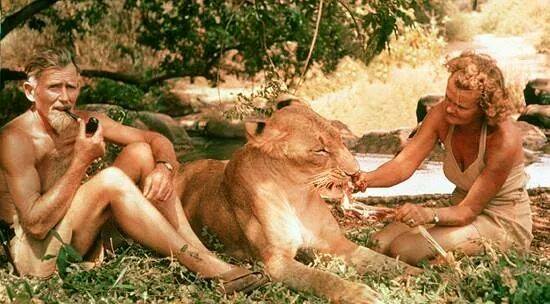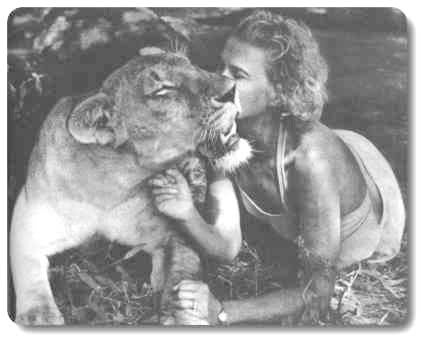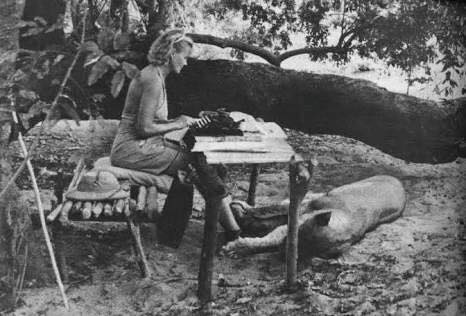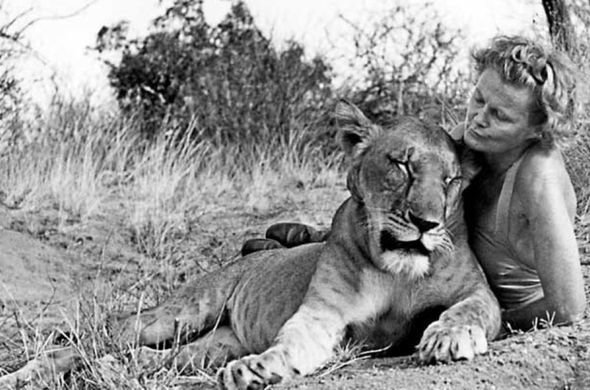Joy Adamson
Self-confessed lion fanatic and writer
Joy Adamson - artist and author
Naturalist and wildlife preservationist Joy Adamson is best known for the books and films depicting her work in Africa, especially her inspirational book Born Free. Adamson spent almost forty years living on game reserves in Kenya, mostly writing and lecturing throughout the world on wildlife conservation.
Friederike Victoria "Joy" Adamson (née Gessner, 20 January 1910 – 3 January 1980) was a naturalist, artist and author. Her book, Born Free, describes her experiences raising a lion cub named Elsa. Born Free was printed in several languages, and made into an Academy Award-winning movie of the same name. In 1977, she was awarded the Austrian Cross of Honour for Science and Art.
Adamson was born to Victor and Traute Gessner in Troppau, Silesia, Austria-Hungary (now Opava, Czech Republic), the second of three daughters. Her parents divorced when she was 10, and she went to live with her grandmother. In her autobiography The Searching Spirit, Adamson wrote about her grandmother, saying, "It is to her I owe anything that may be good in me". She grew up on an estate near Vienna, was educated in Vienna earning a music degree before studying sculpting and medicine. As a young adult, Adamson considered careers as a concert pianist, and in medicine.
Joy Adamson married three times in the span of ten years. In 1935 Joy married Victor von Klarwill. Her new husband, a Jew, decided that the couple should move to Kenya to escape the rising Nazi movement in Austria. In 1937 Klarwill sent his young wife ahead to Africa. Unfortunately, on the voyage there, she met Peter Bally, a botanist. When her husband arrived in Kenya, Joy announced her intention to divorce him. She married Bally shortly afterward, in 1938. It was Bally who gave her the nickname "Joy". Peter did botanical paintings, and it was he who encouraged her to sketch and paint the flora and fauna around her. Bally traveled through Kenya, studying its plant life, and Joy accompanied him. She began to paint their findings, and eventually completed seven hundred paintings that were published in several books. Within only a few years, however, there was a second divorce, closely followed in 1944 by a third and final marriage for Joy. She had met and fallen in love with George Adamson, a game warden in an outlying area of Kenya. Joy Adamson is best known for her conservation efforts associated with Elsa the Lioness. In 1956, George Adamson, in the course of his job as game warden of the Northern Frontier District in Kenya, shot and killed a lioness as she charged him and another warden. George later realized the lioness was just protecting her cubs, which were found nearby in a rocky crevice. Taking them home, Joy and George found it difficult to care for all the cubs' needs. The two largest cubs, named "Big One" and "Lustica", were passed on to be cared for by a zoo in Rotterdam, and the smallest, "Elsa", was raised by the couple. After some time living together, the Adamsons decided to set Elsa free rather than send her to a zoo, and spent many months training her to hunt and survive on her own. They were in the end successful, and Elsa became the first lioness successfully released back into the wild, the first to have contact after release, and the first known released lion to have a litter of cubs. The Adamsons kept their distance from the cubs, getting close enough only to photograph them. In January 1961, Elsa died from babesiosis, a disease resulting from a tick bite (she has a marker on her grave in the Meru Game Reserve in Kenya). Her three young cubs became a nuisance, killing the livestock of local farmers. The Adamsons, who feared the farmers might kill the cubs, were able to eventually capture them and transport them to neighboring Tanganyika Territory (now Tanzania), where they were promised a home at Serengeti National Park. The Adamsons then had to train the cubs, who were too young to be released into the wild, to become hunters. Eventually the cubs were released, but were never sighted again. In the concluding part of Forever Free the Adamsons lost track of the cubs in their new home. After describing a fruitless search, Joy Adamson contemplated a pair of lions: "My heart was with them wherever they were. But it was also with these two lions here in front of us; and as I watched this beautiful pair, I realized how all the characteristics of our cubs were inherent in them. Indeed, in every lion I saw during our searches I recognized the intrinsic nature of Elsa, Jespah, Gopa and Little Elsa, the spirit of all the magnificent lions in Africa". During Elsa's lifetime, Joy and George Adamson needed each other to educate her, but after she died and her cubs were taken in by the park, their interests went in separate directions, as did their lives. While neither wanted a divorce nor a legal separation, their conflicting interests (George wanted to continue to work with lions and she with cheetahs) made it necessary for them to live apart (though they sometimes discussed living together again, they never did). They spent each Christmas together and they remained on good terms. Using her own notes and George's journals, Joy wrote Born Free to tell Elasa's story. She submitted it to a number of publishers before it was bought by Harvill Press, part of HarperCollins. Published in 1960, it became a bestseller, spending 13 weeks at the top of The New York Times Best Seller list and nearly a year on the chart overall. The success of the book was due to both the story of Elsa and the dozens of photographs of her. Readers had pictures of many of the events of Elsa's life leading up to her release. Subsequent books were also heavily illustrated. Born Free received largely favorable reviews from critics. Adamson worked closely with publishers to promote the book, which contributed to the Adamsons' new-found international celebrity. All three "Elsa" books were extremely popular, and films were made of each of them—the 1966 Born Free was the most popular. The stars of the film series, Virginia McKenna and her husband Bill Travers, were so moved by the Adamsons' work that they later founded the Born Free Foundation in England to support wildlife conservation. It is estimated that the "Elsa" series and other Adamson books have been translated into at least thirty-five languages. According to Adrian House's biography, The Great Safari: The Lives of George and Joy Adamson, Born Free served as inspiration for zoologist Iain Douglas-Hamilton, a major activist working to protect the African elephant from extinction. House also notes that anthropologist Desmond Morris credits Born Free with affecting an entire generation's attitude towards animals. After Elsa's death and the release of her cubs, Adamson adopted a young cheetah, Pippa, who had been the house pet of a British army officer. For several years, Pippa was also trained to survive in the wild. Her story is told in Adamson's The Spotted Sphinx. Adamson also studied and worked with a variety of other animals, including baby elephants, buffaloes, and colobus monkeys. Adamson went on an international tour to speak about wildlife preservation in 1962, and became a founder of the World Wildlife Fund and the Elsa Wild Animal Appeal. The money earned from her books was used to set up animal reserves and to fund several preservation organizations. Adamson was also an early activist in the movement to boycott (to protest the selling and using of) clothing made from animal fur. She spent the rest of her life raising money for wildlife, thanks to the popularity of Born Free. The book was followed by Living Free, which is about Elsa as a mother to her cubs, and Forever Free, which tells of the release of the cubs Jespah, Gopa and Little Elsa. Adamson shared book proceeds with various conservation projects. While television specials kept the Adamsons' cause in the spotlight, Adamson spent her last 10 years travelling the world, giving speeches about the perils faced by wildlife in Africa. A book of her paintings, Joy Adamson's Africa, was published in 1972. She rehabilitated a cheetah and an African leopard. Pippa the cheetah was raised as a pet and given to Adamson at the age of seven months in hopes that she could also be released. Pippa had four litters before her death. Adamson wrote The Spotted Sphinx and Pippa's Challenge about Pippa and her cheetah family. Later, Adamson reached her goal of many years, when she obtained an African leopard cub. Penny was eight weeks old when a ranger acquaintance of George Adamson found her in 1976. Penny had a litter of two cubs before the publication of Queen of Shaba, Joy Adamson's posthumous and final book. During her lifetime, she created more than 500 paintings and line drawings. Her work included portraits of the indigenous populations commissioned by the government of Kenya, as well as botanical illustrations for at least seven books on East African flora. She also did animal paintings, among them studies of Elsa and Pippa. On 3 January 1980, in Shaba National Reserve in Kenya (where she had been observing leopard behavior), Joy Adamson's body was discovered by her assistant, Pieter Mawson. He mistakenly assumed she had been killed by a lion, and this was what was initially reported by the media. Her body had been found on a road near her camp in Shaba, and it quickly became apparent to George Adamson and the authorities that human forces were responsible. Her injuries were caused by stabs from a sword-like weapon, not by a lion's fangs and claws. Plus, her tent had been opened, and the contents of a trunk had been scattered. Although authorities eventually convicted someone for the murder, the true story behind Joy Adamson's death remains a mystery. She was several weeks shy of her 70th birthday. The police investigation found Adamson's wounds were too sharp and bloodless to have been caused by an animal, and concluded she had been murdered. Paul Nakware Ekai, a discharged labourer formerly employed by Adamson, was found guilty of murder and sentenced to indefinite imprisonment. He escaped capital punishment because the judge ruled he might have been a minor when the crime was committed. A quiet funeral ceremony for Adamson was held near Nairobi, Kenya. Adamson had specified in her will that her ashes be buried in Elsa and Pippa's graves in the Meru Game Reserve. Her husband and several colleagues did just that. They took her ashes, divided them in half, and placed them in the graves of Adamson's two dear friends. George Adamson was murdered nine years later in August 1989, along with two coworkers, near his camp in Kora National Park, while rushing to the aid of a tourist who was being attacked by poachers. He is credited with saving the tourist's life. The murders were blamed on several shifta, or bandit-poachers, who were roaming the area. Nevertheless, the work of Joy and George Adamson lives on, through the books that Joy wrote and the organizations she founded.Courtesy: Notable Biographies.com and Wikipedia
THE ADAMSON LEGACY
Joy and George set up or were the inspiration for a number of trusts and foundations. Royalties from books and films were also channelled into a charity set up by Joy called the Elsa Wild Animal Appeal. Later, this charity became the Elsa Conservation Trust. Both Joy and George upon their deaths bequeathed their estates to this trust. This included a lovely home they shared during their marriage called Elsamere, in Naivasha, Kenya. Elsamere Conservation Centre Elsamere is located on the southern shores of beautiful Lake Naivasha in the Great Rift Valley. Visitors can see many of Joy's paintings in the house and explore the museum which features memorabilia from the lives of the Adamson's - delightful teas and lunches are served here. There is guest accommodation in the grounds overlooking the lake, plus activities are available such as boating and tours to local attractions. The house is situated in a wildlife area which is also excellent for birding. Elsamere Conservation Trust This trust has been instrumental in many conservation and education projects. It funded the setting up of the Elsamere Centre for Education in Sustainability, established in 1989, keeping the Adamson dream alive through conservation education.Source: KenyaSafari.com
ARTICLES OF INTEREST
The man who taught man about the animals By Becky Barnes with BT News - September 2014.
A lioness names Elsa inspired an epic fight against poachers by Anna Dubuis at BBC - June 2016.
PUBLICATIONS
Born Free (1960) ISBN 1-56849-551-X Elsa: The Story of a Lioness (1961) Living Free: The story of Elsa and her cubs (1961) ISBN 0-00-637588-X Forever Free: Elsa's Pride (1962) ISBN 0-00-632885-7 The Spotted Sphinx (1969) ISBN 0-15-184795-9 Pippa: The Cheetah and her Cubs (1970) ISBN 0-15-262125-3 Joy Adamson's Africa (1972) ISBN 0-15-146480-4 Pippa's Challenge (1972) ISBN 0-15-171980-2 Peoples of Kenya (1975) ISBN 0-15-171681-1 The Searching Spirit: Joy Adamson's Autobiography (1982). ISBN 978-0-7089-0826-6. OCLC 4493290.; also, (1978) ISBN 0-00-216035-8 Queen of Shaba: The Story of an African Leopard (1980) ISBN 0-00-272617-3 Friends from the Forest (1980) ISBN 0-15-133645-8 As illustrator only: Gardening in East Africa, II edition At least six other books depicting the flowers, trees, and shrubs of East Africa Books by others: Wild Heart: The Story of Joy Adamson, Author of Born Free by Anne E. Neimark. Sleeping With Lions by Netta Pfeifer Joy Adamson : Behind the Mask by Caroline Cass. The Great Safari: The Lives of George and Joy Adamson by Adrian HouseFILMS
Born Free Living Free Elsa & Her Cubs - 25 minutes; Benchmark Films Copyright MCMLXXI by Elsa Wild Animal Appeal and Benchmark Films, Inc. Joy Adamson - About the Adamsons - Producer-Benchmark Films, Inc. Joy Adamson's Africa (1977) The Joy Adamson Story (1980) - featuring interviews with Joy Adamson about her life and work in Austria and in Africa, and her famous lioness Elsa. Director: Dick Thomsett Production Company: BBCAdamson Timeline:
1906 – George Adamson is born in India. 1910 – Friederike Victoria Gessner (Joy Adamson) is born in what is now the Czech Republic. 1924 – George Adamson moves to Kenya. At the time, Kenya is still an English colony. 1938 – George joins Kenya’s game department as a warden of the Northern Frontier District. 1944 – Joy and George marry. 1947 – Joy begins a series of paintings to record tribal life and customs. The project takes six years and includes 700 portraits. 1956 – George, now senior game warden, kills a charging lioness while searching for a man-eating lion. He takes her three cubs back to the camp. Two of the cubs, Big One and Lustica, are taken to a zoo but Joy fights to keep the third cub, Elsa. 1959 – George begins efforts to reintroduce Elsa into the wild. 1960 – BBC Presenter David Attenborough travels to Kenya to do a piece on Elsa. 1960 – “Born Free” is published. It is hugely successful, selling 5 million copies and is translated into 24 languages. 1961 – Elsa dies of tick fever and is buried in Meru National Park. 1961 – George retires as a game warden and focuses exclusively on his work with lions. 1963 – Joy founds the Elsa Conservation Trust, an organization committed to wildlife conservation. 1965 – George heads an effort to reintroduce three lions featured in the Born Free film – Boy, Girl, and Ugas – back into the wild. 1966 – Columbia Pictures releases the film Born Free. It becomes a box office hit all over the world and stars real-life husband and wife Bill Travers and Virginia McKenna. They are deeply inspired by their work on the film and become wildlife activists. 1968 – The lion Boy attacks a child. Although he survives, the incident tarnishes the reputation of his rehabilitation program. 1970 – George moves to Kora to continue the program. 1971 – George’s assistant, Stanley, is killed by Boy. George is forced to shoot Boy. 1980 – Joy Adamson is killed in Kenya. Initially thought to be a lion attack, it is later proven that her murderer was an angry employee. 1980 – George’s brother Terence Adamson is mauled by a lion. The Kenyan Government refuses to allow any new cubs to enter the rehabilitation program. 1984 – McKenna and Travers establish the Born Free Foundation, an International wildlife charity working to prevent animal cruelty and suffering. 1986 – George publishes his autobiography, My Pride and Joy. 1988 – The Kenyan Government reinstates George’s program and he is given three orphan cubs to rehabilitate into the wild. 1989 – George Adamson, aged 83, is shot dead by bandits in Kenya. He is buried next to his favorite lion, Boy.


